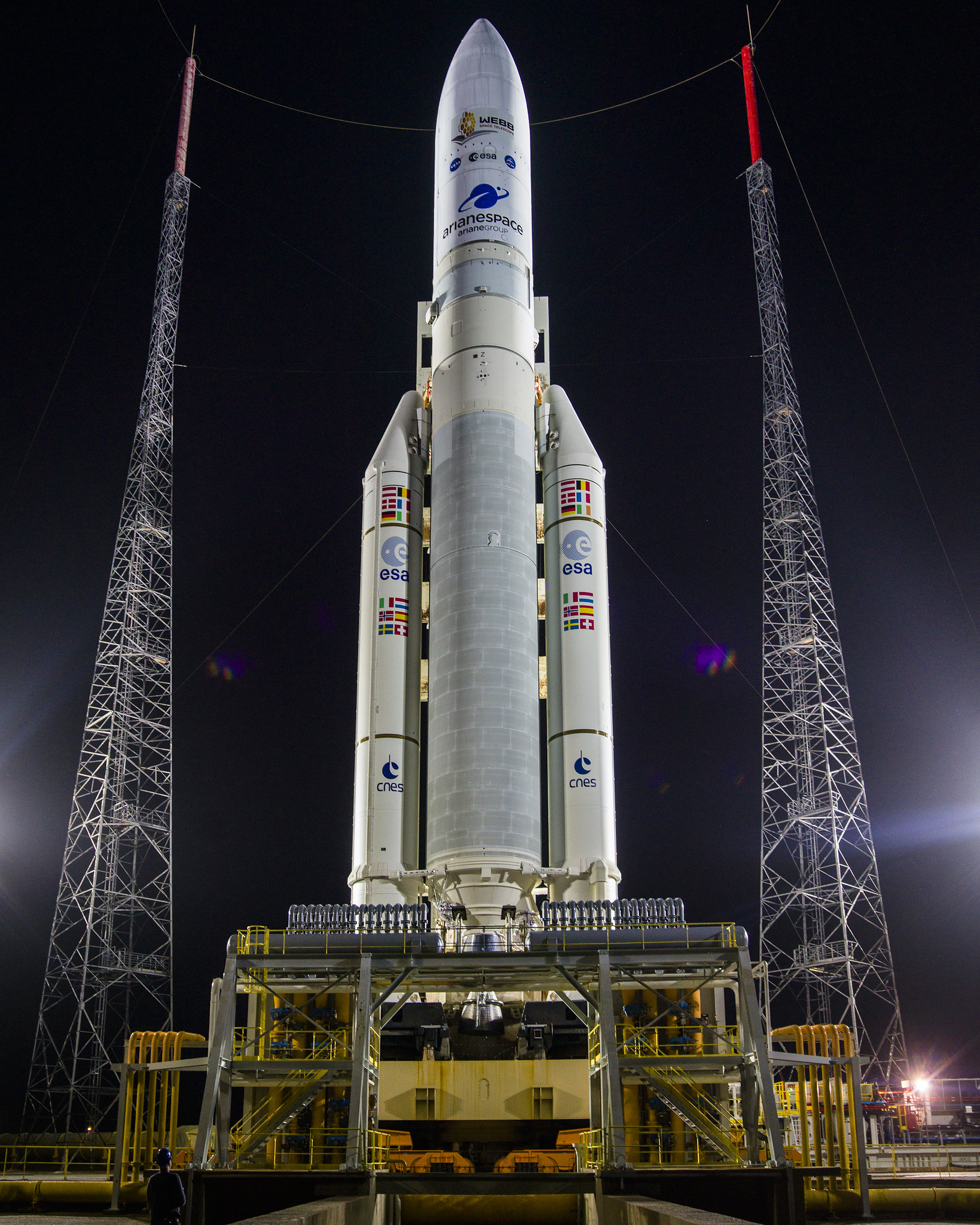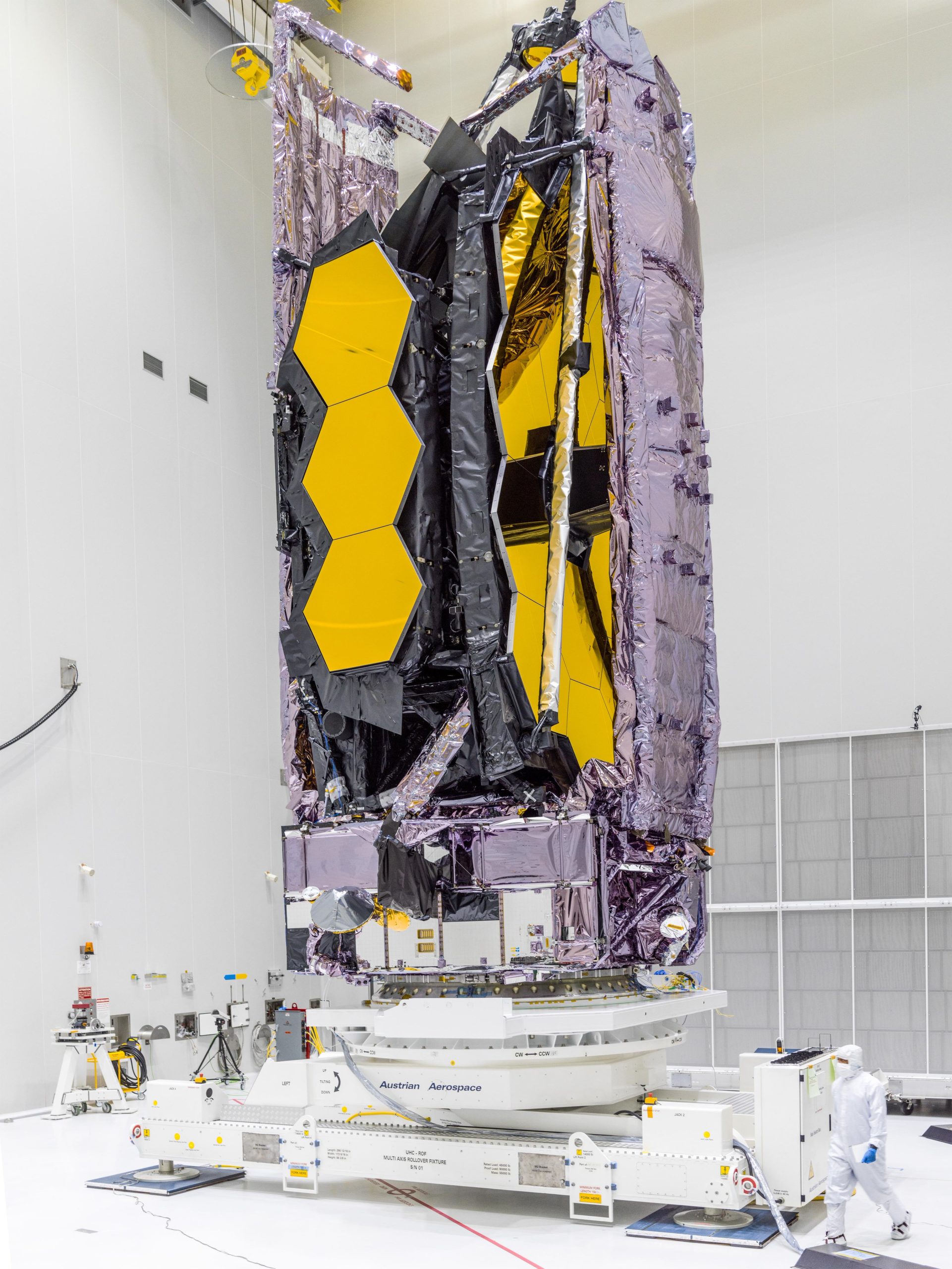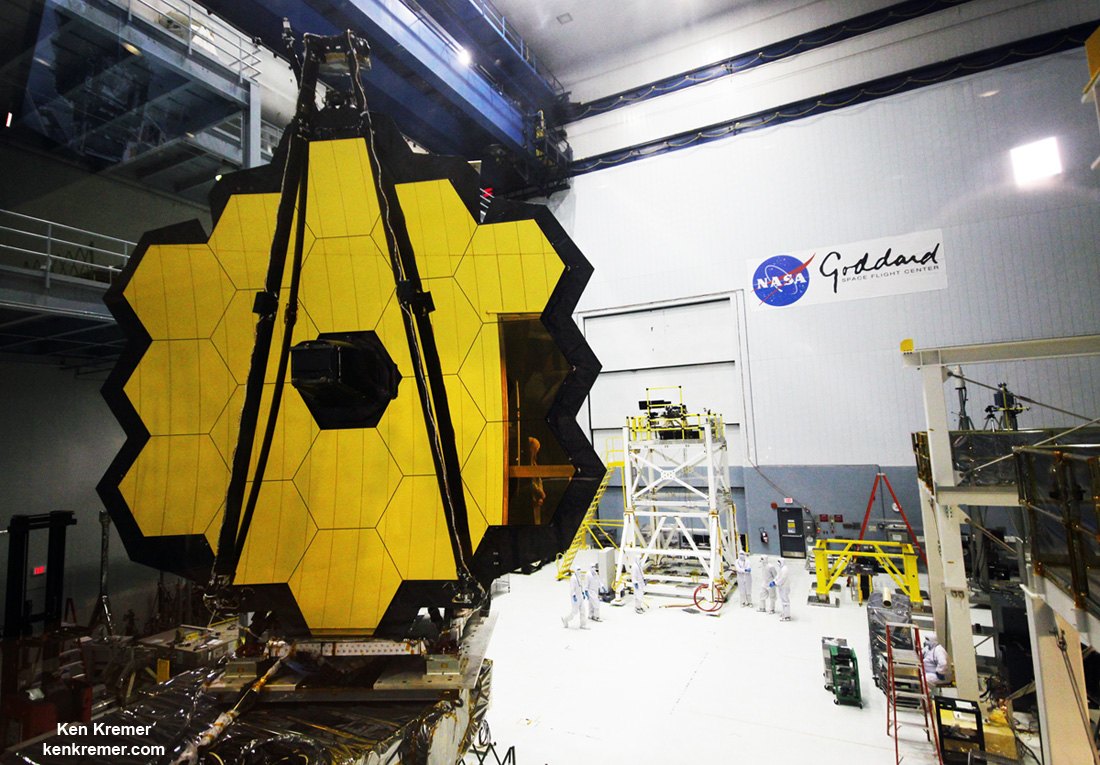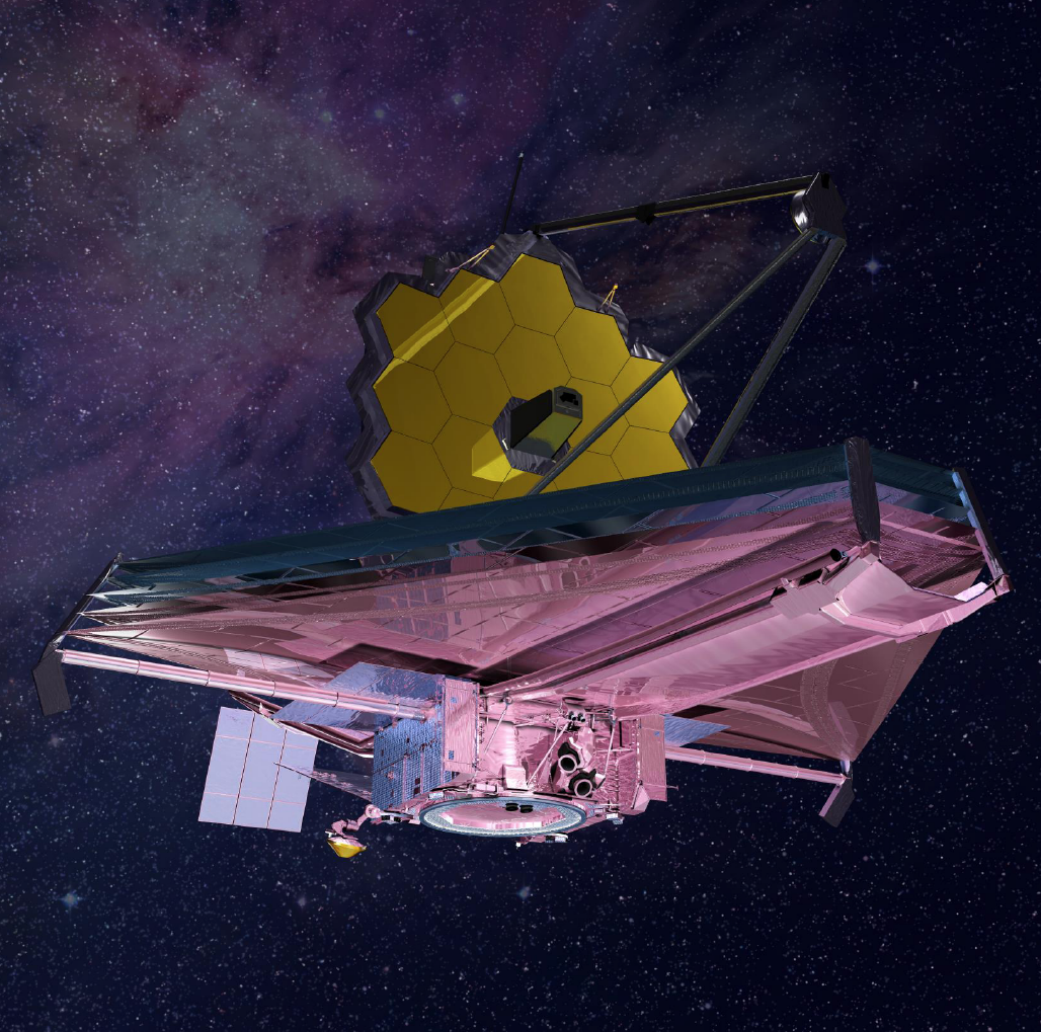
For SpaceUpClose.com & RocketSTEM
CAPE CANAVERAL, FL – Following another delay due to poor weather the fully fueled and integrated NASA James Webb Space Telescope (JWST) has been rolled out to it launch pad, Thursday, Dec. 23, and stands ready for launch to space now targeting Christmas morning, Dec. 25 on an Arianespace Ariane 5 rocket from Kourou, French Guiana – to begin its groundbreaking science observations peering back to nearly the beginning of time that are sure to rewrite astronomy and science textbooks worldwide.
Webb is in many respects a time machine back looking to the formation of the Universe over 13.5 Billion years ago and how we came to be and evolved over the eons.
The infrared observatory will study every phase of cosmic history—from within our solar system to the most distant observable galaxies in the early universe starting within about 200 million years of the Big Bang and see first light from the birth of the first stars and galaxies.
It will look at exoplanets and analyze their composition and atmospheres and search for signs of life in unprecedented resolution.
The Ariane 5/Webb final rollout and launch were postponed a day from Christmas eve morning Dec.24 due to bad weather at the launch site.
But at last everything is finally ready – two decades in the making!
✅ Rollout complete!
The James Webb Space Telescope and the @ariane5 rocket it’s riding on are all settled in their final position on Earth. Next step: launch on Dec. 25 at 7:20 am ET (12:20 UTC) to #UnfoldTheUniverse: https://t.co/ip2P4oAxJW
📸: NASA/Bill Ingalls pic.twitter.com/kkk4JDd5tu
— NASA Webb Telescope (@NASAWebb) December 23, 2021
The $9.8 Billion Webb observatory is targeted to launch at 7:20 a.m. EST (9:20 a.m. GFT / 1220 GMT / 13:20 CET). Saturday, Dec. 25, on a 55 m (180 ft) tall Arianespace Ariane 5 rocket from Europe’s Spaceport in Kourou, French Guiana, on the northeastern coast of South America.
The launch window runs 32 minutes until 7:52 a.m. EST.
Key milestones after liftoff:
~9 minutes: main stage separation
~27 minutes: upper stage separation
~33 minutes: solar array deployed

After that the hugely complex month-long unfurling process of origami-like folded Webb starts.
There are some 344 single point failures that could doom the telescope if not accomplished successfully over the next 30 days as it journeys to its destination orbit 1 million miles (1.6 million km) away.
Next step is commissioning of the telescope and all its hardware and science instruments.
First images are expected in about 6 months.
NASA’s James Webb Space Telescope encapsulated inside the Ariane 5 rocket it will ride to space arrived Dec. 23 at the Arianespace ELA-3 launch complex.

The rocket rollout took about 2 hours to complete.
“With Webb and its rocket securely on the pad, the team will run electrical diagnostics to ensure all lights are green for launch. Teams will power on the observatory while at the launch pad to run one final aliveness test to ensure all systems have power and are working before liftoff,” NASA officials said.
“Ariane 5, standing 53 m high on its mobile launch platform was transported along rails from the final preparation building to the launch zone where final health checks and preparations for liftoff will occur,” ESA announced.
Watch this ESA video of the Ariane 5/Webb rollout
Video Caption: Webb on Ariane 5 roll-out to the Arianespace ELA-3 launch pad on Dec. 23, 2021 at Europe’s Spaceport in Kourou, French Guiana. Credit: ESA
NASA and Arianespace successfully completed the Launch Readiness Review for Webb on Dec. 21 and authorized the Ariane 5 rocket team to conduct the rollout and start of launch sequencing for the mission.
Currently the latest weather forecast still look good for Christmas, NASA’s Thomas Zurbuchen, Associate Administrator for NASA’s Science Mission Directorate reports.
Weather is GO for @NASAWebb launch tomorrow! Let’s begin the journey to #UnfoldTheUniverse! https://t.co/jZHN8l5IhF
— Thomas Zurbuchen (@Dr_ThomasZ) December 24, 2021
Webb is the largest and most powerful science telescope payload ever launched from Earth. It will operate in a halo orbit at the L2 Lagrange point approx. 1 million miles (1.6 million km) from Earth after liftoff and about a 1-month journey.
It is also the most expensive science instrument ever costing nearly $9.8 Billion and also serves as the scientific successor to the wildly successful Hubble Space Telescope.

The encapsulation of Webb inside the 5.4 meter wide Ariane 5 payload fairing atop the rocket was completed by technicians and engineers Friday, Dec. 17.
The fueling and encapsulation process was delayed earlier in mid-November and again in December by a host of issues including resolution of last minute communications glitches that delayed liftoff by another 48 hours and earlier was interrupted in November following an incident that occurred during launch preparations that resulted in unexpected vibrations impacting the entire telescope assembly.
The incident occurred during operations at the satellite preparation facility in Kourou, French Guiana, performed under Arianespace overall responsibility which is responsible for the JWST launch campaign.
Ultimately no problems were found and the launch campaign proceeded.

NASA is planning extensive prelaunch and launch coverage of the JWST mission.
Details here:
https://www.nasa.gov/mission_pages/webb/main/index.html
https://www.nasa.gov/feature/nasa-invites-public-to-share-excitement-of-webb-space-telescope-launch
Live countdown commentary and launch broadcast coverage coverage will begin at 6 a.m. Friday, Dec. 24, on NASA TV, the NASA app, and the agency’s website. The public can also watch live on Facebook, Twitter, YouTube, Twitch, and Daily Motion.
NASA will hold a postlaunch news conference approximately 30 minutes after the live launch broadcast ends on Sat., Dec. 25.
The James Webb Space Telescope is nestled all snug in its rocket, and now visions of launch can dance in your head — and on your screens!
📺 Learn how you can watch along as we #UnfoldTheUniverse on Dec. 24: https://t.co/t7r1hfB8X9 pic.twitter.com/jPUScj5i7X
— NASA Webb Telescope (@NASAWebb) December 18, 2021
See further detailed viewing and coverage details from Amber Straughn, Webb deputy project scientist for communications at end of this story!
Webbs primary mirror is comprised of 18 segmented gold coated individual mirror segment that measure 21.3 feet (6.5 meters) in diameter when unfurled – 6 times wider than Hubble!
Webb is equipped with 4 state-of-the-art science observing instruments.
In space it is protected by a tennis court sized sunshade of 5 layers – each the thickness of a human hair and made of Kapton.
They will be carefully deployed post launch.
They will cool the telescope and its science instruments to near absolute zero at about minus 400 F required to operate its infrared cameras and spectrometers and so that the instruments don’t detect the telescope itself from the heat it radiates thus interfering with research operations
The largest space observatory in history will carry an ultra-cool camera aboard: the MIRI instrument. It’s one of four scientific instruments on @NASAWebb, and to operate, it must be cooled to almost the coldest temperature matter can reach!
Why so cold?👉 https://t.co/pvw3er8r0N pic.twitter.com/gEQNUk785B— NASA JPL (@NASAJPL) December 15, 2021
Given that Ariane 5's fairing is 5.4 meters in diameter and 17 meters tall; do you know the telescope's dimensions?#WebbFliesAriane #ArianeGroup #Ariane5 pic.twitter.com/a1YXySOnNA
— ArianeGroup (@ArianeGroup) December 10, 2021
The Webb Telescope is a joint international collaborative project between NASA, the European Space Agency (ESA) and the Canadian Space Agency (CSA).
Webb is designed to look at the first light of the Universe and will be able to peer back in time to when the first stars and first galaxies were forming. It will also study the history of our universe and the formation of our solar system as well as other solar systems and exoplanets, some of which may be capable of supporting life on planets similar to Earth.
“It will explore every phase of cosmic history – from within our solar system to the most distant observable galaxies in the early universe, and everything in between. Webb will reveal new and unexpected discoveries, and help humanity understand the origins of the universe and our place in it,” says NASA.
I observed JWST many times while under construction at NASA Goddard Spaceflight Center in Greenbelt, MD.
This photo shows the science instrument/mirror module in the Goddard cleanroom after installation of the 18 primary mirrors was completed.

JWST is the largest, most powerful and most complex space telescope ever built. It will serve as the scientific successor to NASA’s world famous and phenomenally successful Hubble Space Telescope (HST).
It will be launched on an Ariane 5 rocket, folded up like origami inside the nose cone which measures 5.4 meters in diameter and 17 meters tall.
Given that Ariane 5's fairing is 5.4 meters in diameter and 17 meters tall; do you know the telescope's dimensions?#WebbFliesAriane #ArianeGroup #Ariane5 pic.twitter.com/a1YXySOnNA
— ArianeGroup (@ArianeGroup) December 10, 2021
At some points the clearances for the intricately folded up telescope inside the Ariane 5 rockets nose cone are as little as 8 inches as the observatory shakes rattles and rolls during blastoff
This NASA video details the complex deployment sequence of JWST post launch remotely controlled from Earth:
Video Caption: Engineers on the ground will remotely orchestrate a complex sequence of deployments in the hours and days immediately after the launch of the James Webb Space Telescope. This animation shows the nominal sequence for these deployments. Music Credit: Universal Production Music “Connecting Ideas Instrumental” Credit: NASA’s Goddard Space Flight Center
Webb is designed for a 5-year lifetime at L2.
If all goes well NASA and scientists hope it can be extended to a 10-year mission life.
Unlike Hubble, Webb is not designed for astronaut servicing to fix or upgrade the massive observatory.
This Ariane 5 mission is numbered VA256 by Arianespace.
The 56 m (180-foot-tall) 2 stage rocket is fueled by liquid hydrogen (LH2) and liquid oxygen (LOX).
Overall it is the 256th launch of an Ariane rocket since Dec. 24, 1979, and the 112th flight of an Ariane 5 since its debut in 1996.
Further details about Launch viewing and coverage from Amber Straughn, Webb deputy project scientist for communications, NASA’s Goddard Space Flight Center:
“As we are all eagerly anticipating launch, you might be wondering how to watch the launch and what to expect. Good news! NASA and its partners are planning a launch broadcast celebration that will be viewable in several different ways. Live countdown commentary and launch broadcast will begin at 6 a.m. EST (11:00 UTC) on Dec. 25 and air on NASA Television and the agency’s website, as well as YouTube, Twitter, Facebook, LinkedIn, Twitch, Daily Motion, Theta.TV, and NASA’s App. You can also join the Facebook event to watch the launch live and interact with others watching the launch. The launch broadcast will continue until approximately one hour past launch, to follow the first several critical milestones post-launch. The actual launch window opens at 7:20 a.m. EST (12:20 UTC) and lasts for 31 minutes – we can launch at any point during that window.
The launch broadcast will include exciting scenes from the launch site in Kourou (naturally!), along with commentary from mission experts from both NASA’s Goddard Space Flight Center and the Mission Operations Center at the Space Telescope Science Institute. In the program you can also expect to see extraordinary video sequences showing construction of the telescope, in-person presentations about key technology, and cutting-edge animations depicting how it will unfold once it gets to space. Tune in to see an exciting new way to learn about the mission science and engineering. There might even be a launch event near you.
After the broadcast is over, follow the progress of commissioning by keeping an eye on our website and social media (Twitter, Facebook, & Instagram), and of course this blog. We will have almost-daily updates here for the first couple of weeks post-launch, and then will go back to a roughly weekly cadence for technical updates.
But you don’t have to wait until launch day to join in on the excitement. Check out the Journey to Space YouTube series, the Elements YouTube series, and if you are the creative type, submit art for our #UnfoldTheUniverse challenge. Find out even more “Need to Know” information here!
I personally cannot believe the day is almost here. I’m so very excited for launch!
— Amber Straughn, Webb deputy project scientist for communications, NASA’s Goddard Space Flight Center
..
More photos of Ariane 5/Webb at the Kourou launch pad from NASA’s Dr. Thomas Zurbuchen:
We visited the Ariane 5 rocket up close before it launches @NASAWebb to space tomorrow. Thank you @CNES and @Arianespace for arranging the visit. #UnfoldTheUniverse pic.twitter.com/QG2ZZPaD03
— Thomas Zurbuchen (@Dr_ThomasZ) December 24, 2021
Watch this space for my ongoing reports on JWST mirrors, science, construction and testing.

Watch Ken’s continuing reports about JWST, IXPE, DART, SpaceX Crew and Cargo Dragons, Artemis, SLS, Orion and NASA missions, Lucy Asteroid mission, SpaceX Starlink, Blue Origin and Space Tourism, Commercial Crew and Starliner and Crew Dragon and onsite for live reporting of upcoming and recent SpaceX and ULA launches including Crew 1 & 2 & 3, ISS, Solar Orbiter, Mars 2020 Perseverance and Curiosity rovers, NRO spysats and national security missions and more at the Kennedy Space Center and Cape Canaveral Space Force Station.
Stay tuned here for Ken’s continuing Earth and Planetary science and human spaceflight news: www.kenkremer.com –www.spaceupclose.com – twitter @ken_kremer – email: ken at kenkremer.com
Dr. Kremer is a research scientist and journalist based in the KSC area, active in outreach and interviewed regularly on TV and radio about space topics.
………….
Ken’s photos are for sale and he is available for lectures and outreach events
Please consider supporting Ken’s work by purchasing his photos and/or donating at Patreon:
https://www.patreon.com/kenkremer





x



